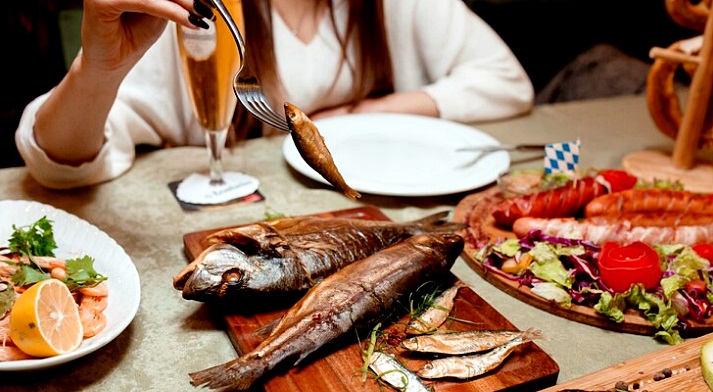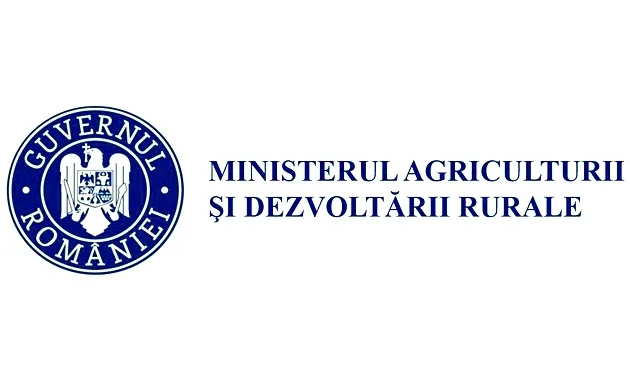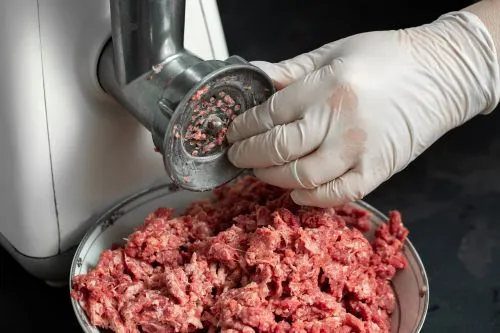
Generally, when conducting studies in Europe regarding consumer behavior, they often focus on population groups in the Western countries. However, recently, two highly interesting analyses have emerged regarding the consumption behavior of populations in Eastern Europe, including Romanians. In this regard, for meat consumption, we have the study "Attitudes and beliefs of Eastern European meat consumers - a review," conducted by researchers from Poland, Hungary, and Slovenia, and for milk and dairy consumption, "Food consumption behaviors in Europe," conducted by the company Valumics.
Everything has changed
Nothing is the same as in the 1990s when it comes to European meat consumption and production trends. We have witnessed an increase in pork and poultry production, while sheep and beef production have declined.
Most likely, the main reason that has pushed European consumers away from beef is their concern about its ecological sustainability, as seen in Japan and Brazil. Health concerns are also a significant issue for meat consumers, followed by a growing interest in societal benefits and more ethical meat production methods.
The attitudes and beliefs of European meat consumers are important for all stakeholders in the food chain, and it is not surprising. What is surprising is that these investigations have almost implicitly excluded meat consumers from Eastern European countries. Consequently, until recently, the attitudes and beliefs of meat consumers in Eastern Europe have remained unknown to scientific researchers, the research community, and the general public.
Therefore, the aim of this analysis was to collect, classify, and summarize all recently published relevant data that would help paint a portrait of an average meat consumer in Eastern Europe.
Eastern European consumers are traditional meat consumers who are not yet eagerly looking to replace their traditional dishes with analogs or substitutes.
In general, vegetarianism is still in its early stages, if we do not consider the fasting period during which Orthodox countries in Eastern Europe consume foods that do not contain meat, dairy, and eggs, which are widely available. Chicken is the most commonly consumed type of meat and is preferred because it is inexpensive and easy to prepare.
Eastern European meat consumers believe that meat from castrated pigs is of better quality, and one-third of them are indifferent to animal welfare issues. The highest proportion of Eastern European consumers (42.9%) believes that game meat has many health benefits, is rich in protein, and is more organic than other types of meat.
However, two-thirds of Eastern European consumers eat game meat less than once a year. The differences in attitudes and beliefs of meat consumers in Eastern Europe compared to their counterparts in Western Europe are evident.
Poultry Meat Consumers
On average, only 2.6% of Eastern European consumers avoid consuming poultry meat, while the majority (51.7%) eat it every two weeks or more frequently. One-fifth (19.8%) consume poultry meat only once a week, while nearly equal percentages consume it once a month (13%) or daily (12.9%).
It is not surprising, as Islam is now the largest religion in Bosnia and Herzegovina, and Bosnians are the most passionate consumers of poultry meat in all of Eastern Europe. Over a third of Bosnians (34.4%) consume poultry meat every day.
The second-highest proportion of daily poultry consumers (21.7%) was observed in Serbia, not for religious reasons but due to economic factors, as poultry meat is the most affordable type of meat available in the Serbian meat markets.
Overall, Hungarian consumers seem to be the least frequent consumers of poultry meat, as 89.8% of them consume it only once every two weeks or even monthly.
On the other hand, although Bulgarian consumers are not among the most frequent consumers of poultry meat in Eastern Europe, they seem to have the highest average consumption of poultry meat in households per month, ranging from 6-9 kg, and poultry meat products ranging from 3-6 kg.
The age group of Eastern European consumers between 50 and 64 years old consumes the largest portion of poultry meat and poultry meat products, ranging from 3-6 kg per month. Women consumers tend to consume less than men on a monthly basis, as the highest percentage of women consumes poultry meat and poultry meat products ranging from 500 g to 3 kg, while the highest number of male respondents consumes poultry meat ranging from 3-6 kg and poultry meat products ranging from 500 g to 3 kg.
The most important quality attribute of poultry meat for Eastern European consumers is its visual aspect, specifically freshness and color as the main qualitative attributes. That is why researchers and the industry are exploring new analytical methods for evaluating the color of poultry meat.
When it comes to retailing poultry meat, Eastern European consumers consider the three most important characteristics to be temperature at the point of sale (28.35%), shelf lighting (22.6%), and product placement (14.7%).
The majority of Eastern European consumers (39.1%) prefer poultry meat because it is easy to prepare and can easily be accompanied by various side dishes. These consumers are predominantly women (64.3%), and poultry meat consumption is perceived as a way to showcase their cooking skills and is considered ideal for children's diets, making poultry meat an important element of the family's diet.
It has also been revealed that the second-largest proportion of Eastern European poultry meat consumers (34.5%) are highly selective consumers who prefer specific cuts of chicken and have specific attitudes regarding a healthy diet. This can be best explained by the fact that they are primarily the working population, which includes more selective and experienced consumers than the younger population in general.
Pork consumers
As an exploratory approximation, we can assume that the largest proportion of Eastern European consumers eat pork every two weeks (43.3% on average and varying from 19.0% in Moldova to 58.5% in Croatia) with almost equal percentages of them consume pork weekly (21.1% on average and ranging from 11.3% in Hungary to 29.4% in Poland) or daily (20.3% on average and ranging from 8, 0% in Hungary to 54.3% in Moldova) [16].
Eastern European pork consumers have positive to neutral preferences for meat from castrated pigs, and piglet castration is not considered a problem to be addressed in this part of Europe. The reasons can be found in the belief that meat from castrated pigs is of better quality.
At the same time, they are ambivalent about the claim that meat from castrated pigs is leaner, apart from Bulgarian pork consumers who believe otherwise. On average, Eastern European consumers are undecided about whether meat from castrated pigs is more expensive than meat from non-castrated pigs, while they are more willing to pay for meat from physically castrated pigs than an average Western European consumer.
Regardless of geographic or demographic determinants, pork color remains the most important quality attribute when it comes to consumers and their preferences, and this has consequently prompted research to find new techniques in pork color evaluation and pork products.
The behavior of Romanian meat consumers
In Romania, the average consumption of meat and meat products per capita in fresh meat equivalent had an upward trend until 2019, followed by a downward trend from 2020 and until 2023.
This situation occurred mainly because of the recent economic crisis that affected the incomes of the population. In Romania, pork is usually consumed, this type of meat having an important role in the diet of Romanians, taking into account the tradition in the consumption of this food.
Poultry takes second place with various benefits: the lower price compared to pork, beef or mutton, its ease of cooking and less pronounced flavor, and last but not least the tendency of consumers to replace red meat with white meat, due to the ease to remove fat from the diet.
In order to analyze the influence of meat production on trade in meat and meat products, in Romania, in the period 2019-2023, statistical analysis methods were applied using the Excel application, Data Analysis module.
The value of the parameter attached to the factorial variable is greater than zero, indicating that there is a direct relationship between meat consumption and meat production. Thus, for an increase of one ton in meat production, meat consumption increases by 33.9 kg.
Attitudes and beliefs regarding animal welfare
In terms of animal welfare attitudes and beliefs, three distinct, but almost identical in size, groups of Eastern European consumers can be identified. The first group (37%) consists of consumers who are concerned about the welfare of animals and they believe that it is possible to achieve.
However, the second group (32%) is consumers who are indifferent to animal welfare. The third group (31%) of Eastern European consumers are concerned about animal welfare, but find it difficult to achieve.
Differences in the attitudes and beliefs of Eastern European meat eaters compared to their Western European counterparts are evident. Meat analogues and substitutes are not yet considered, as consumers are quite satisfied with their traditional meat-based food.
Animal welfare, environmental and sustainability issues are less of a concern due to lower incomes in Eastern Europe compared to the West. The health and wellness food market in Eastern Europe is developing and growing, but is still going through a testing period and looking for some stabilization.
Europeans and the behavior of milk and dairy consumers
Dairy products range from fairly standardized products such as milk, butter and nonfat milk powder to multi-flavored products such as specialty cheeses, fermented beverages, and milk protein fractions used in food and beverage products .
Products such as fresh milk, yogurt and cheese are intended for direct consumption. Dairy products are also consumed indirectly as ingredients in other foods such as pizza, snacks and baked goods. The average consumption of liquid milk in the EU-28 was 53.6 kg/capita/year in 2022.
The United Kingdom (90 kg/capita/year) was significantly above this average, followed by Germany (55.5 kg/capita/year) and the Czech Republic (56.5 kg/capita/year), while France (48 .6 kg/capita/year), Italy (40.7 kg/capita/year) and Iceland (43.5 kg/capita/year) were below this quota.
In terms of total consumption of dairy products, excluding butter, measured in milk equivalents, according to 2022 figures, Germany leads the list, followed by Italy, France, the European Union, Great Britain, Iceland and the Czech Republic.
Decreases milk consumption
Consumption of fresh milk is decreasing, while dairy products, especially those with added value (e.g. organic products or products with a protected geographical indication), as well as cheeses and dairy ingredients added to food products are increasing.
Between 2008 and 2018, liquid milk consumption in the EU fell by 6 kg per capita, from 58 kg to 52 kg. In part, this reflected a shift by some consumers to alternative options. However, per capita market expenditure on dairy products increased in the EU over the same period, particularly in France, Germany and Italy.
The downward trend in liquid milk consumption in the EU is expected to continue between 2018-2030, leading to a consumption level of 49 kg per capita by 2030. On the other hand, the consumption of cheese and processed dairy products is expected to increase in the coming years.
Specifically, the consumption of butter and cheese is expected to increase further to 4.6 and 20 kg/capita/year, respectively, by 2030. Despite the expected decrease in liquid milk consumption, the total intake of dairy products fresh food should fall only slightly to 74 kg per capita in 2030, compared to 77 kg in 2018.
The hypermarket remains the main source of purchase
Milk and milk products are usually bought alongside other food products, with supermarkets and several retailers dominating sales in Europe. In Germany, most dairy sales are made in supermarkets, and 50% in discount stores (Friedrich, 2020).
Similarly, in France, 98% of all liquid milk is bought from supermarkets and hypermarkets. In the Czech Republic, supermarkets and hypermarkets account for 95% and small grocery stores for 28% of sales. Consumers between the ages of 15 and 34 buy directly from farmers, markets and health food stores more often than other age groups.
In Italy, 90% of dairy products are bought from modern food retailers, of which conventional stores account for 5.8%, discounters for 9.3%, hypermarkets for 27.9% and supermarkets for 46.4%. The remaining 10% are purchased from traditional grocery retailers, with an increasing number of families buying milk from discount stores.
In the UK, dairy products are mainly purchased in supermarkets and several retail markets (with own brands). Specifically, four major supermarkets (Tesco, Asda, Sainsbury's and Morrison's, account for 76% of all UK dairy sales. Door milk delivery has fallen from 45% of all milk purchases in 1995 to just 3% in 2014-2015.
Consumer characteristics
Dairy products are consumed regularly and by a broad sector of the population, but consumption varies between and within individual countries for reasons that include socio-demographic aspects and consumer preferences. The differences highlighted below demonstrate that strategies to address dairy consumption can vary by country, specific dairy product and target consumer groups.
Gender: In France, among children, girls generally consume more dairy products than boys. In German schools, the opposite was observed: indeed, gender significantly affects the demand for milk at school, but girls request less milk at school than boys. In the Czech Republic, women consume more dairy products than men.
Income level: Although higher incomes generally lead to higher overall consumption of dairy products, the same cannot be said for consumption of individual products. For example, in several high-income countries, consumption of cheese is increasing, but consumption of liquid milk is decreasing.
Yogurt consumption per capita is also relatively high in high-income countries such as France and Germany, and demand growth is relentless. In Italy, families with a higher income show the biggest decrease in milk purchases. In France, consumption of dairy products is higher among wealthy households. In Germany, on the other hand, the influence of net income on dairy consumption patterns seems small.
Age: In France, 90% of children consume dairy products daily and 63% of adults more than 4 times a week, milk being consumed mainly at breakfast and at home. Also in France, children consume twice as much as adults, and consumption decreases with age, but increases after 65.
Milk consumption is more important when there are children in the family. In the Czech Republic, women consume dairy products mostly between the ages of 30-44 and least between the ages of 45-59.
In Italy, purchases are more stable by older people (64+), while young people (-35) decrease their consumption of dairy products, as they are more inclined to new and trendy consumption styles and open to trying products dairy alternatives.
The typical Italian consumer of fresh milk would be a bit older, with not too much disposable income and belonging to a larger family. In the UK, dairy products are consumed by 96% of the population, mostly at home, and with the highest level of consumption among older consumers (+55) and the least among younger consumers (-35).
Younger consumers are more likely to consume plant-based alternatives. In a German survey, 64% of German respondents consumed dairy products daily (Nutrition Report, 2019), and age difference appeared to play a limited role in consumption levels.
Product preference: France has a higher per capita consumption of soft cheeses than most other EU countries.
Income and availability
Income levels and the availability and cost of milk are key factors behind differences in dairy consumption across Europe. Although higher incomes generally lead to higher overall consumption of dairy products, the same cannot be said for consumption of individual products.
For example, in several high-income countries, consumption of cheese is increasing, but consumption of liquid milk is decreasing. Yogurt consumption per capita is also relatively high in high-income countries such as France and Germany, and demand growth is relentless.
Retail purchases of dairy products are growing at very different rates between European countries in response to rising incomes and urban population growth. Media promotions and new forms of retail channels are also driving increased consumption in countries where dairy products are marketed to Europe's aging population and senior, typically affluent, demographic groups that form an attractive target market for functional dairy foods and beverages, for example.
Functional claims contribute to this growth by giving consumers access to expanded product and brand selections. In France, a multimedia effort several years ago, supported by the media and health professionals, helped to spread knowledge about the harmful health effects of high fat and sugar consumption.
Especially regarding the impact of price, when choosing milk and dairy products in stores, Czech and Romanian consumers are influenced first by price (63% of respondents), then by quality (46%).
The behavior of Romanian milk and dairy consumers
Of the total number of Romanian participants in this study, 96.5% declare themselves consumers of milk and dairy products and 3.5% declare that they do not consume these types of products. Considering the distribution of respondents according to the frequency of consumption, we can see that, of the total number of respondents who consume milk and dairy products, the majority has a frequent consumption.
Romania is a Balkan country and therefore has a long tradition of consuming milk and dairy products. There are some differences that can be seen between gender groups, with women having a higher percentage for daily consumption than men, who have the highest percentage in the 2-3 times/week category.
Considering the differences between age groups, the 30–39 age group has the highest percentage of respondents for occasional frequency, followed by the over 50 age group.
In addition, the 30-39 age group has the highest percentage of respondents in the daily frequency group. An interesting observation emerges from the distribution of age groups; the over 30 categories have the highest percentages in the daily and occasional frequency groups.
Approach to sustainability
After meat, dairy consumption represents the largest environmental impact of food-related lifestyles. The actual climate change effects of dairy consumption depend largely on the quantity and product consumed.
The carbon intensity of butter, for example, is 13 times that of milk, which is already high compared to plant-based products. The EAT Lancet report sets as a future target an average consumption of 250 g of whole milk or equivalent derivatives per day, which means 91.25 kg of liquid milk per capita/year.
Achieving such a goal would require reducing dairy consumption to about a third of the forecast consumption for 2030, which is estimated to reach 74 kg of fresh dairy products (including liquid milk), 4.6 kg of butter and 20 kg of cheese per person. in the EU, in a normal scenario.
As in the case of meat consumption, changing dairy consumption patterns may require both replacing, to a certain extent, dairy products with plant-based alternatives, as well as opting for products with higher quality and sustainability standards, often associated with products from local and small-scale agriculture.




